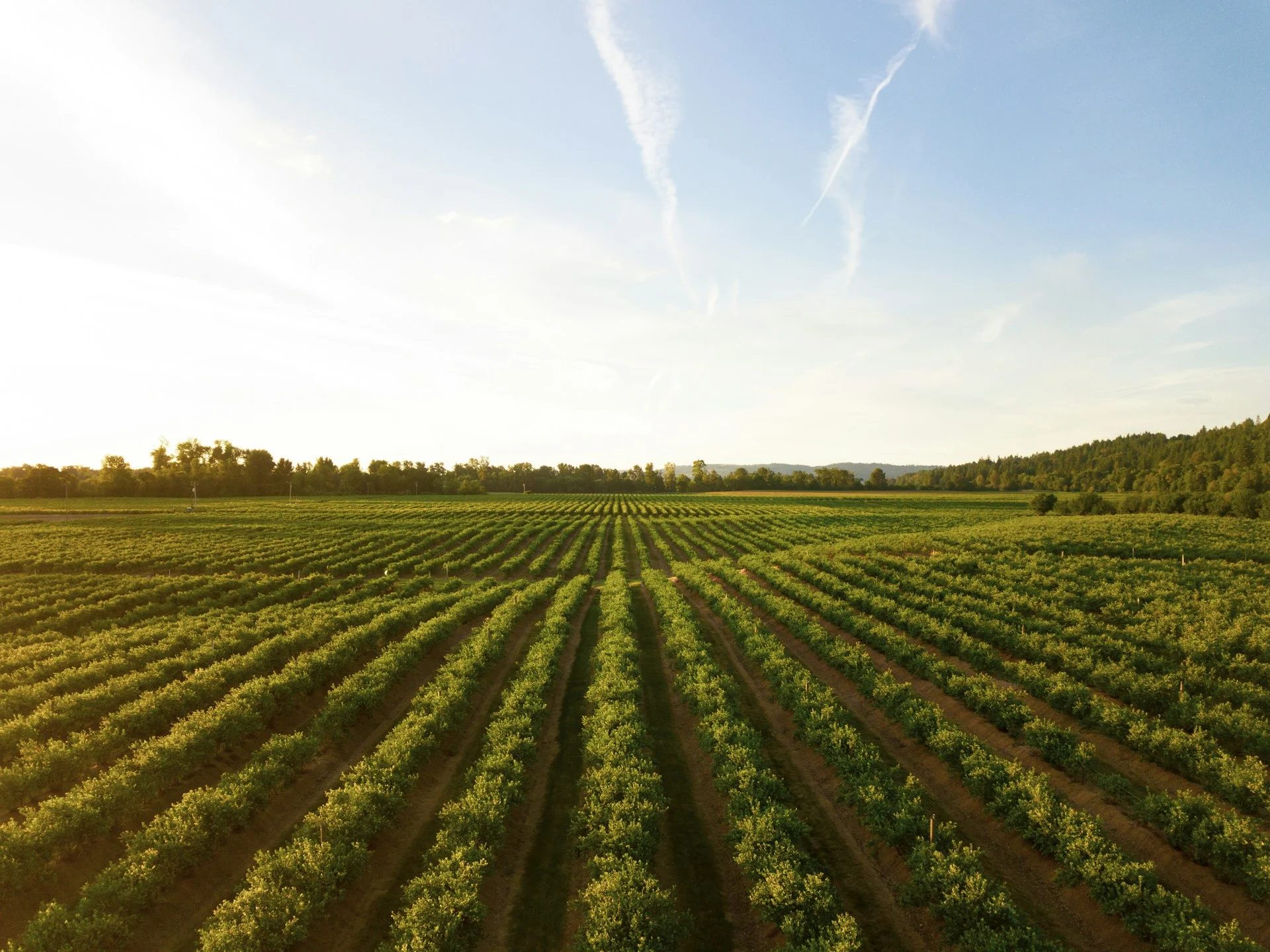Table of content
While it’s usual to see its applications as software, AI has many means of helping traditionally manual-labor industries like manufacturing, mining, or, for instance, farming. Recent studies indicate that AI usage in farming is projected to grow significantly, with the market expected to reach $4 billion by 2026. Currently, around 25% of large farming operations are already integrating AI technologies to improve yield, efficiency, and sustainability.
AI in agriculture refers to the use of artificial intelligence tools to enhance various farming practices. From precision farming to automated harvesting, AI is helping farmers optimize their operations and improve crop yields. This technological revolution is not only increasing efficiency but also promoting sustainable farming practices.
We see farmers, agricultural technologists, and sustainability enthusiasts increasingly turning to AI to address the growing demands of food production and environmental sustainability. To navigate you through what AI is doing in agriculture, in this article, we will explore the changes it brings to the process and alterations it emphasizes, review the successful implementations, and try to gaze at its future trends.
The Current State of Agriculture and the Need for Innovation
Agriculture is the backbone of human civilization, yet it faces numerous challenges today. With a growing global population and climate change threatening crop yields, the need for innovation in agriculture has never been more critical. Traditional farming methods are no longer sufficient to meet the increasing demand for food.
Farmers are struggling with issues such as soil degradation, water scarcity, and pest infestations. These challenges necessitate the adoption of new technologies to ensure sustainable food production. AI technology in agriculture is emerging as a viable solution to address these problems, offering innovative ways to improve efficiency and productivity.
The integration of AI in agriculture is not just about boosting yields; it also aims to create a sustainable and resilient agricultural system. By leveraging AI, farmers can make data-driven decisions, optimize resource usage, and minimize their environmental footprint.
How AI is Transforming Farming Practices
Precision Agriculture Optimizing Inputs for Maximum Yield
Precision agriculture is one of the most significant advancements brought about by AI technology in agriculture. This approach involves using AI to collect and analyze data on various aspects of farming, such as soil conditions, weather patterns, and crop health. The goal is to optimize the use of inputs like water, fertilizers, and pesticides for maximum yield.
AI-powered sensors and drones can provide real-time data on soil moisture levels, nutrient content, and crop health. This information allows farmers to make informed decisions about when and how much to irrigate or apply fertilizers. By optimizing input usage, precision agriculture helps reduce costs and minimize environmental impact.
For example, AI-driven irrigation systems can determine the exact amount of water needed for each crop, preventing over-irrigation and conserving water resources. Similarly, AI can analyze soil data to recommend the precise amount of fertilizers required, reducing chemical runoff and promoting soil health.
AI in Crop Monitoring and Disease Detection
Crop monitoring and disease detection used to require patience and a trained eye, while AI now involves machine learning. AI-powered drones and satellite imagery can monitor large fields and detect early signs of crop stress or disease. This is how farmers can now take timely action and prevent significant yield losses.
AI algorithms can analyze images captured by drones or satellites to identify patterns and anomalies that indicate crop diseases or pest infestations. For instance, AI can detect changes in leaf color, shape, or texture that signal the presence of diseases. By identifying issues early, farmers can apply targeted treatments and minimize crop losses.
In addition to disease detection, AI can also monitor crop growth and predict harvest times. This helps farmers plan their activities more efficiently and ensures that crops are harvested at the optimal time for maximum quality and yield.
Automated Harvesting and Weeding
Manual labor in agriculture is often time-consuming and physically demanding. AI is addressing this challenge by enabling automated harvesting and weeding. AI-powered robots equipped with advanced sensors and machine learning algorithms can identify and pick ripe fruits or vegetables with precision.
Automated harvesting robots can work around the clock, increasing productivity and reducing labor costs. These robots use AI to differentiate between ripe and unripe produce, ensuring that only the best quality crops are harvested. This technology is particularly beneficial for labor-intensive crops like strawberries and tomatoes.
Similarly, AI-driven weeding robots can identify and remove weeds without harming the crops. These robots use computer vision and machine learning to distinguish between crops and weeds, applying targeted treatments to eliminate unwanted plants. By reducing the need for chemical herbicides, automated weeding promotes environmentally friendly farming practices.
Case Studies Successful AI Implementations in Agriculture
Global Examples of AI Technologies in Action
Several successful AI implementations in agriculture showcase the potential of this technology to transform farming practices. Let’s look at some notable examples from around the world:
Blue River Technology
Blue River Technology, a subsidiary of John Deere, has developed AI-powered “See & Spray” technology that uses computer vision and machine learning to identify and target weeds. This technology allows for precise herbicide application, reducing chemical usage by up to 90%.
FarmLogs
FarmLogs is an AI-driven platform that provides farmers with real-time data on crop health, soil conditions, and weather forecasts. By analyzing this data, farmers can make informed decisions about planting, irrigation, and harvesting, leading to increased efficiency and yield.
Prospera Technologies
Prospera Technologies is an Israeli agtech company that uses AI to monitor and analyze crop health. Their platform leverages computer vision and data analytics to provide farmers with actionable insights, helping them optimize their farming practices and improve productivity.
Their Impact on Farm Efficiency and Sustainability
The implementation of AI technologies in agriculture has had a profound impact on farm efficiency and sustainability. By automating tasks and providing data-driven insights, AI has enabled farmers to optimize their operations and reduce resource wastage.
For instance, precision agriculture techniques have resulted in significant water savings and reduced chemical usage. Automated harvesting and weeding robots have increased productivity and decreased labor costs. Additionally, AI-powered crop monitoring systems have helped farmers detect diseases early and take preventive measures, reducing crop losses.
Overall, the adoption of AI in agriculture has led to more sustainable farming practices, ensuring that we can meet the growing demand for food without compromising the environment.
Challenges and Opportunities in Adopting AI in Agriculture
Economic Social and Environmental Considerations
While AI offers numerous benefits for agriculture, its adoption also presents several challenges. One of the primary concerns is the economic cost associated with implementing AI technologies. Many small-scale farmers may find it difficult to afford the initial investment required for AI-powered equipment and platforms.
Social considerations also come into play, as the adoption of AI may lead to job displacement in the agricultural sector. However, it is essential to recognize that AI can also create new job opportunities in fields such as data analysis, programming, and equipment maintenance.
Environmental considerations are equally important. While AI can promote sustainable farming practices, it is crucial to ensure that the technology itself is environmentally friendly. For example, the manufacturing and disposal of AI-powered devices should have minimal environmental impact.
Overcoming Barriers to Entry
To overcome the barriers to entry for AI adoption in agriculture, several measures can be taken. Governments and organizations can provide financial incentives and subsidies to help farmers invest in AI technologies. Training programs and workshops can equip farmers with the necessary skills to use AI effectively.
Collaboration between technology companies and agricultural institutions can also facilitate the development of affordable and user-friendly AI solutions. For farmers to actually start using AI in their daily practice, this technology needs to be accessible both on the level of understanding and de-facto implementation. To put it simply, raising awareness about the long-term benefits of AI adoption could be a great strategy to spread the word, while the nuance of availability should be covered by the emergence of new AI agriculture applications.
The Future of AI in Agriculture
Emerging Trends and Technologies
The future of AI in agriculture looks promising, with several emerging trends and technologies set to revolutionize the industry. One such trend is the use of AI-powered robots for precision farming. These robots can perform tasks such as planting, fertilizing, and harvesting with unparalleled accuracy, reducing resource wastage and increasing productivity.
Another emerging trend is the integration of AI with the Internet of Things (IoT). IoT devices can collect real-time data on various aspects of farming, such as soil moisture, temperature, and humidity. AI algorithms can then analyze this data to provide actionable insights, helping farmers make informed decisions.
Last but not least is the progress in ML and computer vision branches. These technologies enable more accurate crop monitoring, disease detection, and yield prediction, further improving farm efficiency and sustainability.
Predictions for the Next Decade
Over the next decade, we can expect AI to play an even more significant role in agriculture. AI-powered technologies will become more affordable and accessible, allowing farmers of all scales to benefit from their advantages. The widespread adoption of AI will lead to increased efficiency, productivity, and sustainability in the agricultural sector.
We may also see the development of new AI applications tailored to specific crops and farming practices. For example, AI could be used to optimize vertical farming systems or develop personalized farming recommendations based on individual farm data.
Just like any technology, AI in agriculture aims to make crops better and agrarians’ work more productive without preying on the human resource. If farmers use AI applications wisely and direct it into a right flow, humanity will get a chance to grow global demand for food while preserving our planet’s resources.
Conclusion The Role of AI in Creating a More Sustainable Future for Agriculture
Whatever challenges Mother Nature, environment and climate change pose to farmers, AI stands on the side of the latter helping them make the crops grow. Be it automated harvesting and weeding, crop monitoring, or other precision agriculture practices, artificial intelligence brings longed-for sustainability and alternative.
There still are economic, social, and environmental considerations to address in order to implement AI in agriculture on a more daily level, however, this work is partially completed directly in the process of implementing and using the given AI solutions. Provided how AI’s benefits in this field are tremendous yet very identifiable, it gives room to create adequate workplaces and a way to integrate machine and human work in the most harmonious way possible.
Apart from side-by-side work with human professionals, we can expect farming AI to emerge more on the market: among ready-made solutions, the battle, most likely, will be for operational speed and word-of-mouth recognition. Let Devox free you from waiting for such a solution to emerge: our team can develop a full-scale AI system for your farming tasks, starting with thorough consulting and proof-of-concept stage. Your software will be based on your unique requirements and business logic you would like to see.
Nevertheless, the most sustainable and resilient agriculture that meets the needs of the growing global population requires more than just AI development; implementing the latter should only be a brick in the global plan of environmental rescue.












